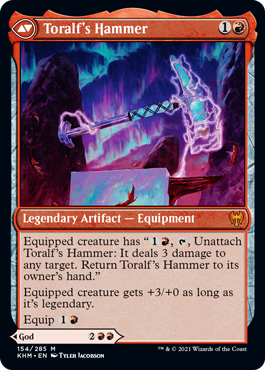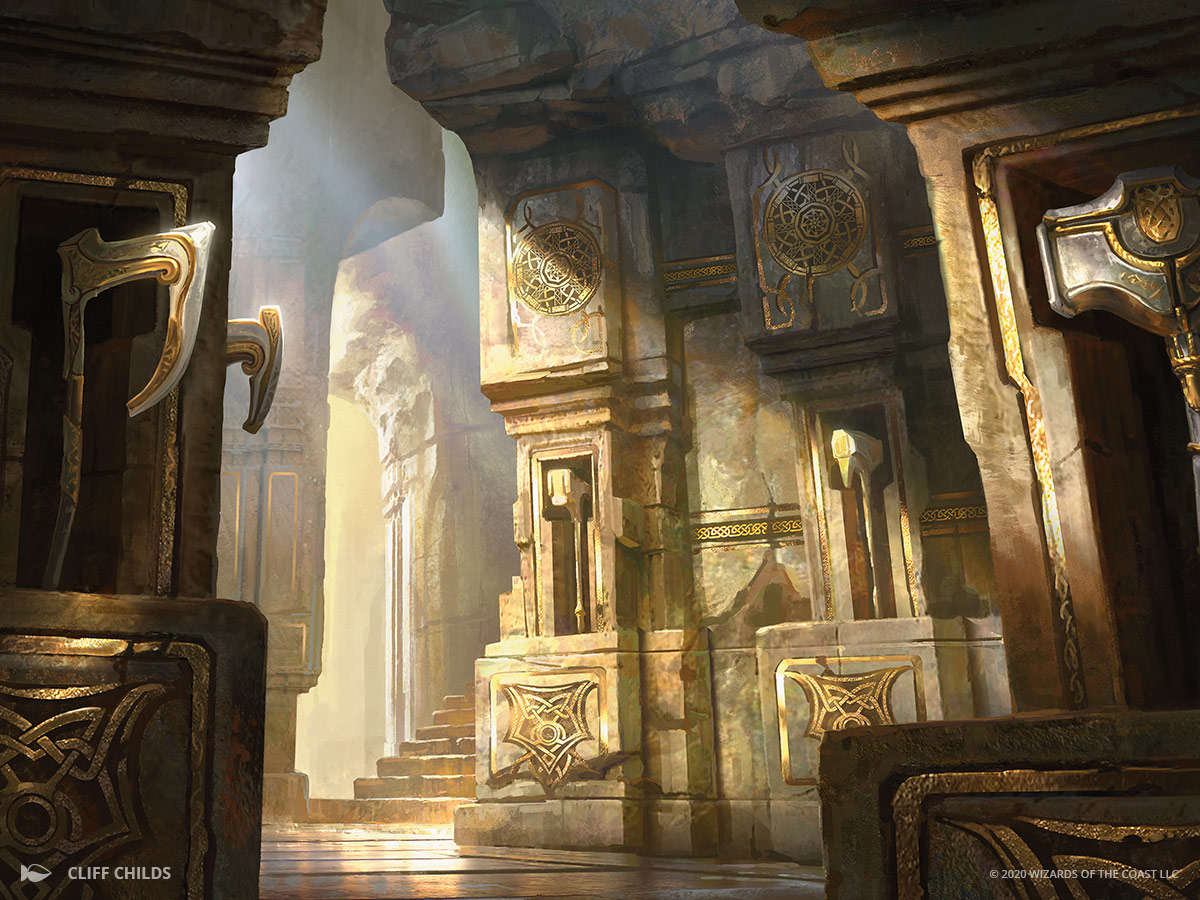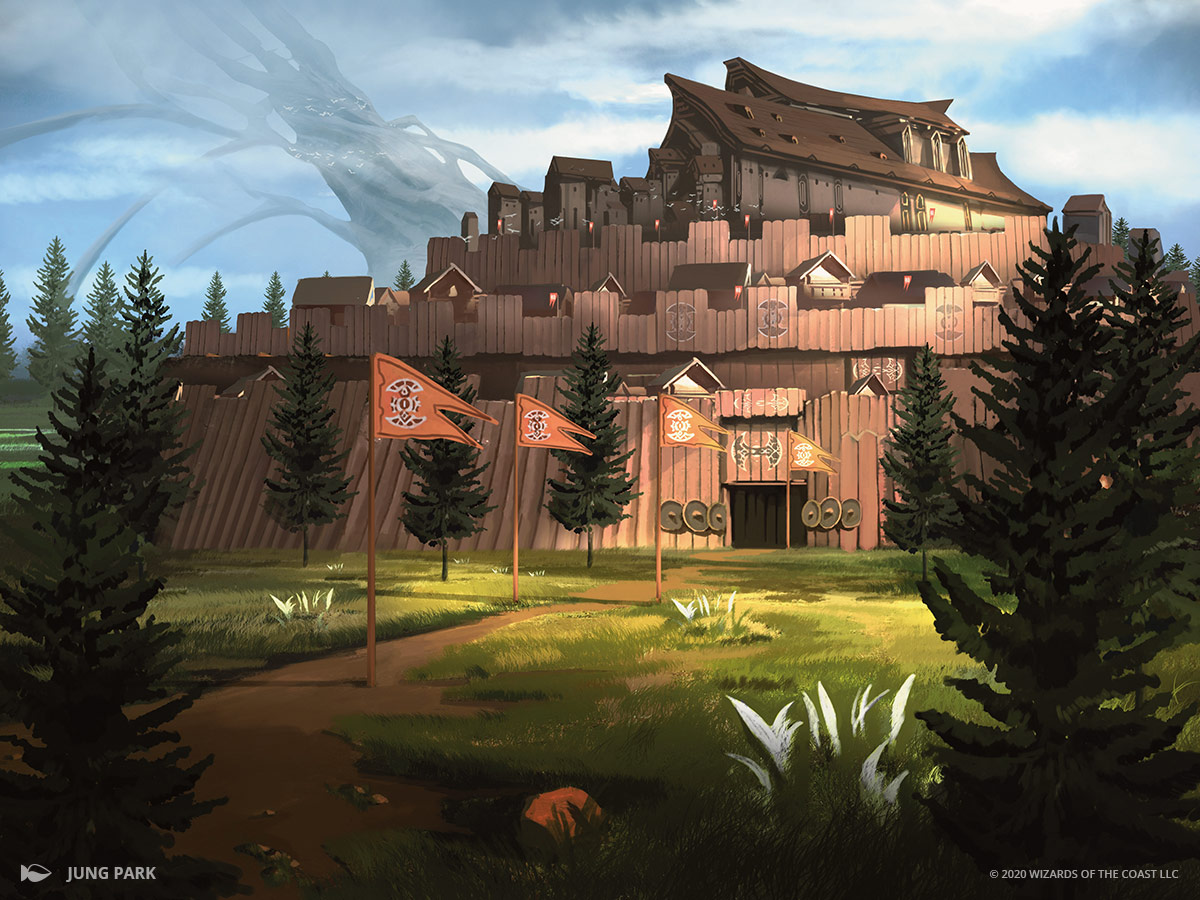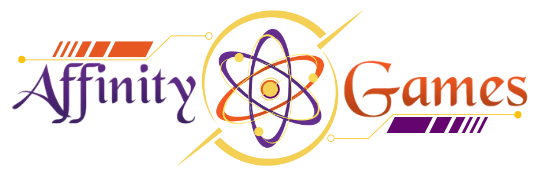#797: RANDY BUEHLER
31:42
In this podcast, I interview Randy Buehler, member of the Pro Tur Hall of Fame and former R&D member.

*Disclaimer
All rights belong to Wizards of the Coast
to see the full article, click here:
Posted in Making Magic on January 11, 2021
Welcome to my first Kaldheim preview article. Today and next week, I'll be walking you through the story of the set's design as well as showing off a cool preview card each week. I hope you enjoy the story of how Kaldheim's design came to be.
The idea of doing a set based on Norse mythology and historical Vikings has been on our to-do list for a long time. In the early days, we avoided it because we felt it would feel too similar to Ice Age (Magic's sixth expansion and second large expansion) which had Scandinavian influences. In the later years, it kept coming up and getting beat out by something else. We were constantly saying, "Not here, but definitely someday." We had a long list of settings that our fans were asking for, so we kept pulling other ideas from the list. Eventually, as we executed on the many other world ideas on the list, a Norse-inspired set rose to the top to be the most requested world we hadn't done yet.
Flash forward to the meeting where we're planning out the three-year stint from Throne of Eldraine through the spring set of 2022. A Norse set got put on the list of possibilities, as it always did. Aaron Forsythe spoke up and said, "What if we actually made the Norse set rather than saying 'one day we'll do it'? Let's put it on the schedule." And just like that, Kaldheim (codenamed "Equestrian") was finally a set we were making. I was leading the design for Zendikar Rising (Zendikar has a soft spot in my heart) and Strixhaven (it was a set based on a mechanical idea I'd pitched), so I tagged Ethan to lead the vision design for Kaldheim. Ethan is a fan of Norse mythology, so he was eager to do it. Dave Humpherys was going to be the lead set designer for Kaldheim.
The first thing we did was figure out what exactly the audience would expect of a set inspired by Norse mythology and historical Vikings. Here's an abbreviated version of the list we came up with:
It was a good list and gave us a lot to work on. For the design story, I'm going to walk you through each item explaining what we did in vision design and then talk about how it was added to, tweaked, or reimagined during set design.
We'd done Gods before on both Theros and Amonkhet, but the gods from Norse mythology felt a little different. In Greek and Egyptian mythology, gods stood apart from humankind. They were someone the humans prayed to but very rarely interacted with. In Norse mythology, gods were treated more like royalty than spiritual beings. You looked up to them, but they had a sense of humanity to them. We wanted to capture that. Also, we'd done Gods before, so them just being gods wasn't exciting enough. We wanted to find a way to design them that made them feel unique. These weren't just any gods—they were Norse gods.
We found our solution to this problem very early. You see, I'd pitched Strixhaven as a set built around modal double-faced cards (MDFCs), but early exploration into their design made me realize that we had something bigger than just one set, so I decided to stretch the MDFCs to all three premier, non-core sets of the Magic "year." Zendikar Rising used their MDFCs to focus on cards that all had a land on the back face. For Kaldheim, we had to figure out how we wanted to use MDFCs. What happened next was what I call a "peanut butter cup moment."
For those unaware of what peanut butter cups are, it's a popular candy in the United States that combines chocolate and peanut butter. For years, the main manufacturer of peanut butter cups in America ran an ad campaign where one person had a bunch of chocolate and another had a jar of peanut butter. For various reasons that changed from commercial to commercial, the two would accidentally run into each other and say, "You got your chocolate in my peanut butter." "Well, you got your peanut butter on my chocolate." They would then discover that the two taste great together, and thus, the peanut butter cup was born.
This means that a "peanut butter cup moment" is when you have two different quests you've created for yourself for your design and you realize that by combining them, they solve each other's problems. That's exactly what happened with Gods and the MDFCs. In fact, the very card that created the "you got chocolate in my peanut butter" moment is my preview card. Let me show it to you, and then I'll explain what happened.


Here's what happened. We were in a Kaldheim vision design meeting. We were doing an exercise similar to what we did above, but rather than larger themes, we were talking about specific cards we had to make. What would the audience be most upset about us not taking on in Kaldheim? I started by saying, "We need our version of Thor and obviously a legendary hammer Equipment." My eyes went wide. "What if they're on the same card? What if all of our Gods are MDFCs?"
We then started listing all the Gods we thought we wanted and all the options for what could be on the backside. It could be a weapon, or a companion, or a vehicle, or a magical item. It didn't take long to create a lot of possibilities. Before the end of that meeting, we had the rough idea of many of the Gods that would make it to print in the set. As you will see as more previews happen, there are a lot of neat God designs. We stuck to the rule that the backside had to be a permanent. The front was a God, and the back was a thing or creature that was associated with that God.
The Vision Design team also explored doing other things with the MDFCs in addition to the Gods, but we eventually came to the realization that all the Gods in Kaldheim being MDFCs and all the MDFCs in Kaldheim being Gods (except for the four Pathways to finish the cycle started in Zendikar Rising) was a perfect match, a "peanut and chocolate moment," if you will. I am very happy with how the Gods turned out. I can't wait for you to see them all.
One of the key elements of Norse mythology is the concept that there are nine unique worlds all connected by the world tree, Yggdrasil. Whenever we make a set, we're always on the lookout for elements of our source material that connect to Magic in some way. Unique worlds that characters can walk between? That sounds familiar. What if we captured the essence of the nine realms by making them each their own plane and there is some element, a world tree, of course, that allows people a means to cross between the realms? Also, we made one other tiny tweak. Because the color pie is the foundation of Magic, it really likes multiples of five. What if instead of nine realms, Kaldheim had ten?
To help differentiate the realms, we associated each one with two colors of magic. One color would be the primary color, and one would be the secondary color. Primary versus secondary doesn't matter too much, but it comes up, such as what color the land from that realm taps for in the uncommon land cycle. Two worlds would have each color as its primary and two would have each color as its secondary. As I'll get to in the next section, we knew we wanted creature types to matter in some way, so we chose to have each realm be closely associated with one creature type. That doesn't mean that's the only creature on that realm, just that it's the focus from a mechanical and flavor standpoint.
With that out of the way, let's talk about each of the realms. (Note: A lot of these descriptions are taken straight from the world guide, and you can also tour the realms here.)
Axgard

Primary color: White
Secondary color: Red
Focus creature tribe: Dwarves
This is a world of rugged peaks and rocky flatlands where the dwarves live in the mountains. The dwarves are artisans that craft amazing artifacts.
Bretagard

Primary color: Green
Secondary color: White
Focus creature tribe: Humans
This is a world of sprawling grasslands and a vast ancient forest surrounded by perilous, storm-tossed seas. This is the home of the humans and is the main place where you will see our take on the Vikings. While the world is green-white focused, there are Vikings here from all five colors. Each color has its own Viking clan (white is Beskir, blue is Omenseekers, black is Skelle, red is Tuskeri, and green is Kannah).
Gnottvold

Primary color: Red
Secondary color: Green
Focus creature tribe: Trolls
This world has rolling hills and ancient mountains blanketed by thick forests. It is the home of the trolls.
Immersturm

Primary color: Black
Secondary color: Red
Focus creature tribe: Demons
This is a land of fire, demons, and constant warfare. The world is bound in powerful runic wards that are not always effective at containing its demonic raiders. Immersturm was first seen as a plane card in Planechase.
Istfell

Primary color: White
Secondary color: Blue
Focus creature tribe: Spirits
This mist-shrouded realm at the base of the World Tree is where most people go after their death, spending eternity as spirits.
Karfell

Primary color: Blue
Secondary color: Black
Focus creature tribe: Zombies
The undead draugr (zombies) are the only remnant of an ancient and prosperous civilization, but their fortresses have crumbled into ice-covered ruins.
Littjara

Primary color: Blue
Secondary color: Green
Focus creature tribe: Shapeshifters
A mysterious realm of lakes and pine forests is home to an equally enigmatic race of shapeshifters.
Skemfar

Primary color: Green
Secondary color: Black
Focus creature tribe: Elves
The shadowed forests of this realm are home to a race of elves descended from ancient gods.
Starnheim

Primary color: Black
Secondary color: White
Focus creature tribe: Angels
Winged battle angels called Valkyries select the worthy dead to spend eternity with them in their feasting hall in this realm.
Surtland

Primary color: Red
Secondary color: Blue
Focus creature tribe: Giants
This snowy world is a realm of constant geological turmoil inhabited by two races of fierce giants locked in never-ending war.
Most of the monocolor cards will show up in one of the four realms that have their color in them, but there are some exceptions like the non-green, non-white Viking clans. The set also has a number of ten-card cycles that show off the ten realms, including the basic lands (there's one from each realm), an uncommon land cycle, an uncommon legendary creature cycle, and a rare Saga cycle. (I should point out that the stories from the Sagas aren't quite one per realm, but it is a two-color cycle of ten cards.)
We'd toyed with ideas of having Sagas in Kaldheim from very early in vision design. Sagas, including the word "saga," was such a perfect fit for a Norse/Viking-inspired world. Once we realized we had the ten realms, doing ten two-color Sagas (all the Sagas in Dominaria had been monocolor) was a no-brainer and got put right in the set. The Sagas also do a great job of telling many of the stories from the various realms to help give a little history of Kaldheim.
I grouped this as a single category, but when we were first made the list, we just wrote down a lot of creature types. "We have to have Giants." "We're going to have Elves, right?" "Dwarves are for sure." "How do we not have Valkyrie Angels?"
The fact that creature types seemed so central to this world made us examine the idea of doing something tribal. The problem was there were a lot of creature types we wanted to care about. We weren't really interested in this being a tribal faction set (like say Onslaught, Lorwyn, or Ixalan), so we ended up borrowing an idea from a mechanic we cut from a set we never made. That set was "Salad," the small set that was originally going to accompany Dominaria (codenamed "Soup"). The mechanic was called leader, and it functioned in a way that whenever you played a leader card, you chose a leader from among your creatures, and that card granted an ability to your leader. If you played a second leader card, you had the option of changing who your leader was, but both cards would grant abilities to a single leader. "Salad" was originally going to be the giant fight against the Demonlord Belzenlok and his evil forces. We liked leader as a combat-focused mechanic. But then "Salad" turned into Core Set 2019 and leader went away with the set.
This is important because we thought we could adapt leader to a tribal mechanic. We ended up calling it clan. Clan worked similarly to leader. When you played a clan card, you chose a creature type, and the card affected that creature type. Then when you played a second clan card, you could rechoose your creature type, but both effects would affect the one chosen tribe. We liked it in vision design because it made for interesting moments in Limited where your clan choice could change as the game evolved.
Clan got handed off from vision design to set design. In Constructed, it ended up working identically to "choose a creature type" because your deck was most likely built around one creature type. In Limited, it ended up making playtesters tank (R&D slang for stopping and thinking for a minute or more to optimize the right choice). There was usually a correct choice based on what creatures you had on the battlefield, but because the effects were ongoing, many players wanted to think about their deck to examine if they might want to set up a card they had in their hand or maybe even something they hadn't drawn yet but could draw later. Tanking is not necessarily bad if the decisions lead to interesting gameplay, but clan was making people think for a long time about factors that seldom mattered. That led set design to change the clan cards to things that were just one-shot effects at low rarity. Eventually, they just removed the mechanic from low rarity cards and changed the higher rarity ones to "choose a creature type." Numerous of those cards remain in the set.
The one other solution to this problem was to leave some individual tribal cards (most of the creatures associated with a realm above have at least one card that mechanically cares about it) and add changeling to the set. (Changeling is an ability that makes a creature have every creature type.) The Creative team had already built a realm, Littjara, with Shapeshifters. What if they just all had changeling? That would allow decks with blue or green to help supplement any tribal needs in Limited.
Much like we wrote down a lot of creature types on our original list, we also wrote down a bunch of weapons. Norse mythology and Vikings are both very associated with weapons. Thor, for example, has his hammer. Vikings have swords, axes, polearms, etc. We knew that we were going to want Equipment to play a role as a subtheme in the set. In early vision design, we experimented with an ability we named enhanced. "Enhanced" meant that you were either enchanted or equipped. The ability went on creatures and gave them an extra ability if they were enhanced. We ended up pulling the keyword from the set during vision design, but it stayed on a number of cards, two of which made it through set design to print.
The other Equipment mechanic ended up being created during set design and appears on a cycle of uncommon cards. Each is an Equipment that has a cost you can pay when the card enters the battlefield. If you pay it, you create a creature token (all the ones chosen for this cycle come from the ten creature types associated with the realms) that the Equipment then attaches to.
The set also has a number of other Equipment, including two MDFC Gods that have an Equipment on their back face (I previewed you Toralf and his hammer above) and a number of cards that care about Equipment in various ways. The Equipment subtheme is not too big, but big enough to give the set some flavor.
That's all the time I have for today. I hope you're enjoying Kaldheim so far. Next week, I'll get to our two named mechanics, boast and foretell, and talk about how snow ended up in the set. As always, I'm eager for your feedback about today's article or any of the components I talked about. You can email me or contact me through any of my social media accounts (Twitter, Tumblr, Instagram, and TikTok).
Join me next week for part two of Kaldheim's design story.
Until then, may you find the realm you feel most at home in.
31:42
In this podcast, I interview Randy Buehler, member of the Pro Tur Hall of Fame and former R&D member.
28:02
This is the first of a two-part series talking about the 45 colorshifted cards in Planar Chaos. I talk about which cards they were colorshifted from and why they were in the set. I also talk about which ones were us testing changes for the future.
Posted in Making Magic on January 11, 2021
